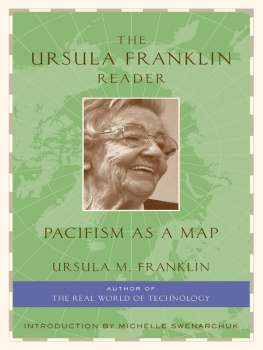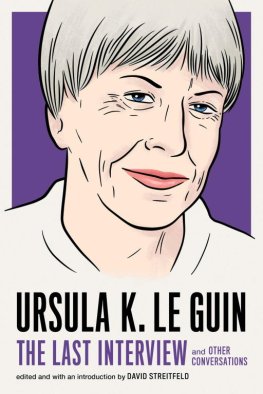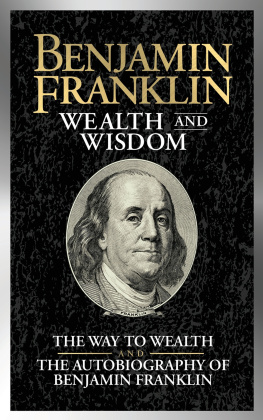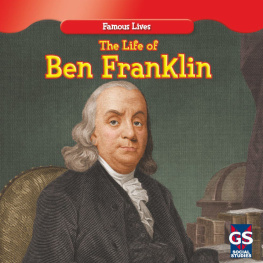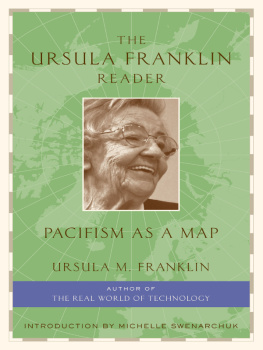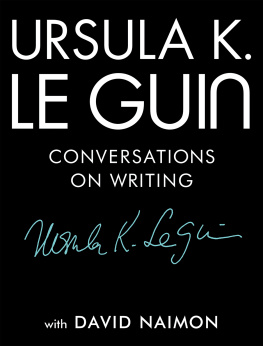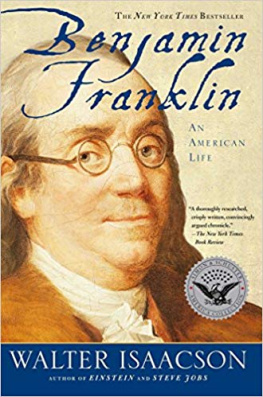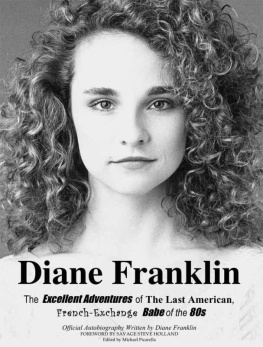
THE URSULA FRANKLIN READER
THE
URSULA FRANKLIN
READER
PACIFISM AS A MAP
URSULA M. FRANKLIN

INTRODUCTION BY
MICHELLE SWENARCHUK
BETWEEN THE LINES
TORONTO
The Ursula Franklin Reader
2006 by Ursula M. Franklin
First published in 2006 by

Between the Lines
401 Richmond Street West, Studio 277
Toronto, Ontario M5V 3A8
1-800-718-7201
All rights reserved. No part of this publication may be photocopied, reproduced, stored in a retrieval system, or transmitted in any form or by any means, electronic, mechanical, recording, or otherwise, without the written permission of Between the Lines, or (for photocopying in Canada only) Access Copyright, 1 Yonge Street, Suite 1900, Toronto, Ontario, M5E 1E5.
Every reasonable effort has been made to identify copyright holders. Between the Lines would be pleased to have any errors or omissions brought to its attention.
Cataloguing data available from Library and Archives Canada
ISBN 978-1-926662-70-1 (epub)
ISBN 978-1-926662-71-8 (PDF)
ISBN 978-1-897071-18-2 (print)
Cover and text design by Jennifer Tiberio
Author photo: courtesy of Ursula M. Franklin
All other cover photos: iStock International Inc.
Between the Lines gratefully acknowledges assistance for its publishing activities from the Canada Council for the Arts, the Ontario Arts Council, the Government of Ontario through the Ontario Book Publishers Tax Credit program and through the Ontario Book Initiative, and the Government of Canada through the Book Publishing Industry Development Program.

To Fred Franklin, my husband, friend, and
companion for more than half a century
CONTENTS
, BY MICHELLE SWENARCHUK
I T IS AN IMPOSSIBLE task for me to acknowledge fully the individual help, support, and stimulation that enabled me to carry out the work assembled in this Reader. Each talk or essay represents my response to a specific situation, and I am forever indebted to all who were part of providing context and occasion: those who have agreed, andeven more sothose who have disagreed with my thoughts.
Yet, without the ongoing love and support of my family, my religious community, and my sisters of the womens movement, I would not have had the strength and endurance to engage in this work for so long.
The actual creation of this Reader could not have taken place without my friendship with and the co-operation of Michelle Swenarchuk. Our wide-ranging conversations, our discussions and examinations of individual papers, and our decisions on their selection and ordering shaped this book. Michelles refusal to be acknowledged as a co-author should not distract from her central role in the development of this collection. To her go my profound thanks.
The massive undertaking of turning a stack of reprints into an editorially and technically defensible manuscript was flawlessly accomplished by my friend Ruth Pincoe. I cannot think of anyone who could have brought the same degree of professional skill and personal empathy to the task, and I am most grateful for her help and advice.
Kathy Chung, on whose assistance and computer savvy I have depended for many years, became an integral part of the project and contributed much to it.
The Three Guineas Foundation provided financial help for the preparation of the electronic manuscript, which we acknowledge gratefully.
And then there is Massey College. Its hospitality and openness continue to sustain me, and the generosity and friendship of Master John Fraser and Elizabeth MacCallum have made my work both possible and enjoyable. The publication of this Reader is an expression of my indebtedness to the ideals of Massey College.
INTRODUCTION
BY MICHELLE SWENARCHUK
U RSULA FRANKLINS words and actions have long been an inspiration to me, and several years ago I began to urge her to publish a collection of her non-scientific social writings. I believe they contain a wealth of knowledge and a loving perspective on the human and natural condition of our time. Our collaboration on this project, an honour and joy for me, has included many wide-ranging discussions of interlinked themes: peace, Quaker faith practice, womens equality, nature, government, citizens activism, and education.
Early in our discussions Ursula identified the basis of her perspectiveher pacifism and her belief that only a commitment to ethical means and non-violence in all human actions can address the problems of society and lead to a peaceful, just, and egalitarian world. From her I learned of the Quaker focus on the importance of individual conscience-based decision-making, not only when it comes to the choices of daily living, but also in acting on the most momentous national and global issues. Quakers do not apply dogmatic instruction to lifes questions. Rather, they use a collective process of prayer, study, and discernment to guide their decisions.
In current political discourse the idea of pacifism tends to be either dismissed as nave and unrealistic or disparaged as connoting appeasement and passivity in the face of force. There is no reflection in mainstream political thinking of the Quaker idea that commitment to a moral means of problem-solving provides a creative impetus to resourceful, non-violent, and humane political policy, even though, as Ursula makes plain, the dysfunctionality of violence as a means of problem-solving stares us in the face.
When Ursula asked me to provide an introduction to the articles to make the argument for the practice of pacifism, I came to realize that her viewpoint has a second foundationher feminism, born of her life experience as a woman and as a scientist, engineer, university professor, mother, and member of an embracing womens community. In all of these spheres she has asked questions that are different than those asked by her male colleagues, and she has provided different answers using language and imagery from womens experience.
Ursula considers that her pacifism provides an alternative map to view the world, illuminating the present and past in a different light. My role here is to highlight the salient features of her map: particular aspects of the human and natural world that become visible when viewed from this perspective. I believe that on this map and with her words and actions we can recognize a creative pathway towards a more hopeful world.
For members of the Religious Society of Friends (Quakers), pacifism isnot a prescription for passive-ism.
Given that they reject participation in war and the use of violence for any cause, Quakers are committed to an active engagement in the pursuit of peace and justice. They consider that non-violent means provide a positive witness to the better way.
Friends have made important contributions to scholarship regarding war, the causes of war, and approaches to peacemaking. Over time their refusal to participate in war helped lead to the modern right of conscientious objection to military service. More recently they have attempted to extend the principle of conscientious objection to the conscription of tax revenues for military preparations in times of peace. Quakers are committed to acting in the world, believing that wherever life places us, there will be needs and openings for our witness, and what is required of each of us is to be present where we are. Friends believe they have an obligation to refuse to co-operate with laws that violate Gods laws and to do so openly. Such actions may encourage others to follow their convictions and support them in their struggles. Friends are advised to live adventurously.
Next page
